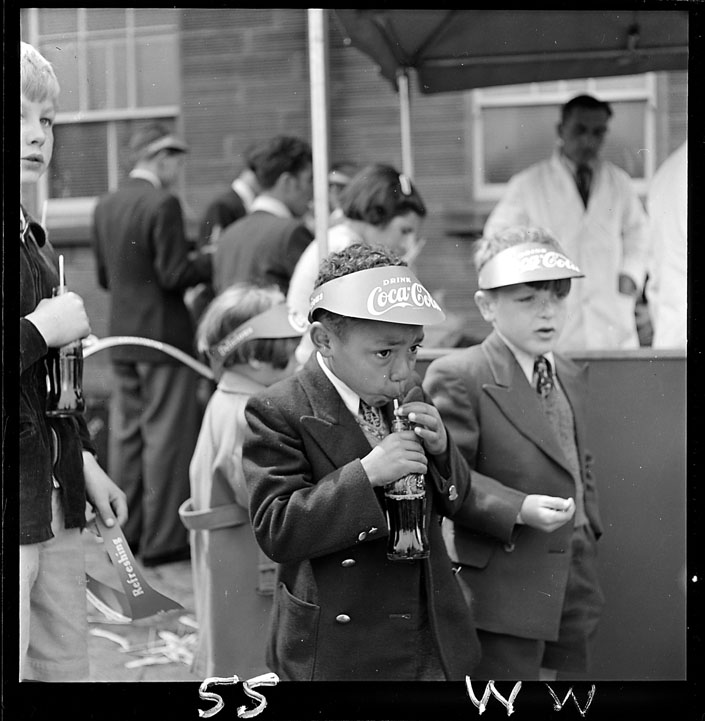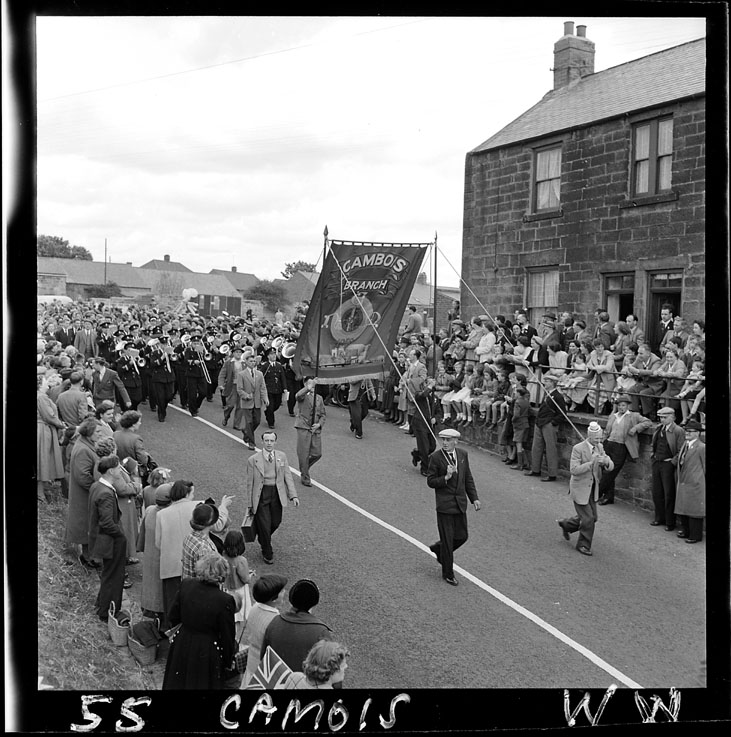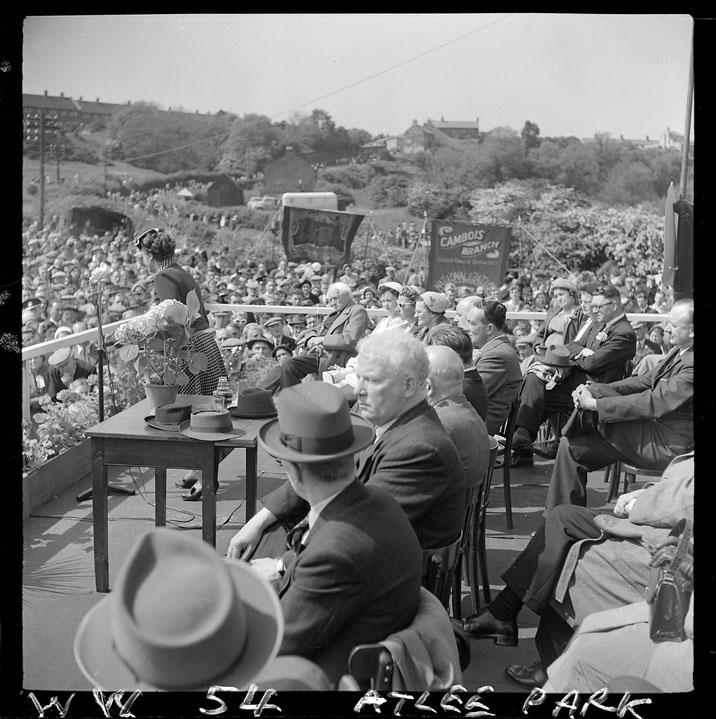Miners’ Picnic Photographs, 1950s
Reference: NRO 6371/1, 3, 14, 42
Suggested age groups: KS1, KS2, KS3, KS4, Lifelong Learners
Subject areas: History, Literacy, Art, Music, Politics
CONTEXT
RO 06371/3 Black and white photograph of boys drinking bottles of Coca Cola at Miners’ Picnic. Taken 1955.
NRO 06371/14 Black and white photograph of the Northumberland Miners’ Picnic procession marching through Bedlington. People line the streets on both sides of the road. Four men are holding the NUM Cambois Branch Banner. A brass band is marching in the background. Taken 1955.
NRO 06371/26 Black and white photograph of speech at Attlee Park, Bedlington. Crowds fill Attlee Park. Men and women are seated on a raised platform in the park listening to a woman making a speech. Taken 1954.
NRO 06371/42 Black and white photograph of a crowd of people enjoying the picnic at Attlee park, Bedlington. Families sitting on the grass in the park surrounded by miners’ banners. Taken 1958.
The earliest Miners’ Picnic took place in 1864 in Blyth. The Morpeth Herald contained a report of the picnic, a transcript is available on this page.
The first few picnics took place in Blyth, but it was also held in Morpeth for a number of years and was associated with Bedlington in the 1950s-1970s. The event also took place in Tynemouth, Ashington and on the Town Moor in Newcastle. Since the closure of the mines, Museums Northumberland have taken over the organisation of the Picnic. The Picnic has been held at Woodhorn Museum near Ashington since 1992.
The Picnics were made up of a series of events. To begin with, representatives of the mining communities would march to the meeting place. Each mine would have its own banner, and many would also have a brass band that would accompany them on the procession.
The brass bands entered competitions which were judged on the day of the Picnic. Winning bands were awarded trophies (Burt Challenge Cup and Northern Divisional Coal Board Challenge Cup).
Communities from around the county also chose beauty queens. Each colliery queen would then compete to become “Picnic Queen” or “Labour Queen” at the Picnic. These two Queens would then sit on a float at the beginning of the procession.
Once the procession was over speeches would be given by local and national political figures. Famous speakers at the Picnics included Betty Boothroyd, Clement Atlee, Hugh Gaitskell, Aneurin Bevan and Michael Foot.
There were also entertainments for children, including games, funfairs, and food.
Trade Unions are organisations that represent a group of employees (or sometimes employers) in a particular job or profession. Trade Unions represent their members in negotiations and disagreements. Trade Unions are often involved in pay discussions as well as campaigning for better working conditions for their members. Miners’ Picnics were organised by Trade Unions.
Northumberland Miners’ Association (NMA) was formed in 1864. Members paid a subscription (or “subs”) to become a member. In 1944 the NMA became part of National Union of Mineworkers. The motto of the NUM is “The Past We Inherit The Future We Build”.
Monster Miner’s Picnic – On Monday, the usually quiet town of Blyth was the scene of unwonted animation, the excuse of which was a monster picnic, under the management of the committee of the Northumberland Miner’s Mutual Confident Association, which was held on Blyth Links. Hundreds of pitmen, their wives and children, from the colliery villages in the district, arrived at the Links during the forenoon, and continued to arrive in groups throughout the day, until they numbered several thousands. The weather was fine and sunny, but the high wind which raised the sand and dust rendered it rather unpleasant to the visitors. Bands of music played through the streets and were followed to the Links by crowds of people.
About one o’clock a public meeting was held; Mr Richard Fynes occupied the chair, and in opening the proceedings said, they had assembled there that day with two objects in view, recreation and amusement, and to endeavour to build the union stronger than it had hitherto been. After suggesting the desirability of establishing a candle and powder fund, he expressed himself sorry to see such a bad feeling existing amongst the leading men connected with the union. The council themselves had suffered, but notwithstanding this, he was proud to say that the union in Northumberland was stronger today than it was twelve months ago. The collieries were all working harmoniously, with the exception of Sleekburn, where the men were out on strike. – Mr T Watson then spoke on the beneficial results of unity. – Mr Joseph Sheldon addressed the meeting on the efficacy of union. – Mr Wakenshaw, of Barrington advocated the principles of the union. – Mr W Crawford (secretary), moved “that the whole of the miners use their efforts to get the first ‘shift’ put back.” – The motion, on being seconded, was put to the meeting and carried unanimously.
At the conclusion of the meeting the visitors amused themselves in various ways. Some played at quoits, others joined in festive games, and a large marquee had been erected, but the boisterous wind had stripped it of its roof, and the company partook of tea in the denuded tent under the clear canopy of the sky. The committee themselves supplied the tea, but the bread was served up by Mr Older of Morpeth.
The Miners’ Picnic
Every year the Northumberland miners’ hold the ‘Miners’ Picnic’. This has been held annually for nearly one century. The miners’ have the picnic so that each year the men from collieries all over Northumberland can get together to celebrate a gallant years work in the mine. During this century the picnic has been held at Morpeth, but for the past two or three years it has been held at Bedlington.
One of the highlights of this year’s picnic was when Hugh Gaitskill the Labour Party representative came from London to talk to the miners. The speeches or talks are held in a large field in Bedlington where hundreds of miners flock to hear the M.P.s speak in their favour.
Each colliery has a beauty queen competition and one girl is chosen to be beauty queen of the colliery. In the Cambois competition, Elizabeth Spencer was chosen as Cambois Colliery Beauty Queen. After each colliery has chosen a beauty queen she goes forward and from all beauty queens a ‘Picnic Queen’ and a ‘Labour Queen’ are chosen. The two queens are allowed to be in a float which goes down the main street in Bedlington in front of the bands. There is also a competition for the best colliery band in Northumberland.
The main street in Bedlington is decorated with stalls selling all kinds of produce, and streamers are thrown over the bands as they march down the streets. All traffic is stopped in the main street of Bedlington so that people can move freely up the street.
The fairground is extremely popular with the children as all kinds of entertainment are there.
I enjoyed myself very much at the picnic, but I was sorry that I missed the main procession this year. Many of the miners went to public houses after the picnic was over and the day after the picnic I am sure many of the miners would have a hangover. The sad thing is that I am sure many of the miners go to the picnic to get drunk and have what they think is a good time, and soon the whole object of the picnic will die out.
ACTIVITIES
ACTIVITY 1
Background
The earliest Miners’ Picnic took place in 1864 in Blyth. The Morpeth Herald contained a report of the picnic, a transcript is available on this page.
The first few picnics took place in Blyth, but it was also held in Morpeth for a number of years and was associated with Bedlington in the 1950s-1970s. The event also took place in Tynemouth, Ashington and on the Town Moor in Newcastle. Since the closure of the mines, Museums Northumberland have taken over the organisation of the Picnic. The Picnic has been held at Woodhorn Museum near Ashington since 1992.
The Picnics were made up of a series of events. To begin with, representatives of the mining communities would march to the meeting place. Each mine would have its own banner, and many would also have a brass band that would accompany them on the procession.
SEE
See: What is a Miners’ Picnic?
See: When was the first Miners’ Picnic held?
See: Where was the first Miners’ Picnic held?
See: Where else have Miners’ Picnics been held?
See: What activities take place at Miners’ Picnics?
See: Who holds Miners’ Picnics today?
See: What is shown in each of these photographs?
THINK
Think: What can you infer from the photographs about who would have attended Miners’ Picnics?
Think: What can you infer from the photographs about the size of the Picnic
Think: Who might attend a Miners’ Picnics today?
Think: Why did the location of the Miners’ Picnic change?
Think: How many collieries might have been represented at each Miners’ Picnic?
Think: What was the original objective of the Miners’ Picnic?
Think: How have miners’ picnics changed over time?
DO
Do: Choose one of the photographs. Write a script for a conversation which might have been taking place when the photograph was taken.
Do: Read the article about the first Miners’ Picnic.
Do: Watch the videos of the Miners’ Picnics in Bedlington.
Do: Watch the video of the Museums Northumberland Miners’ Picnic.
Do: Compare the three versions of the Miners’ Picnic.
Do: Discuss what you can infer about the mining community from Miners’ Picnics.
Do: Plan your own Miners’ Picnic.
Do: Create a poster for your Miners’ Picnic.
Do: Learn to sing some miners’ songs.
Do: Write your own miners’ song.
Do: Design your own mining banner.
Do: Discuss who you would invite to be a speaker at your Miners’ Picnic.
Do: Write a speech to be performed at your Miners’ Picnic.
Do: Host your Miners’ Picnic. You could sing your miners’ song and parade your mining banner.
Do: Write a newspaper article about your Miners’ Picnic.
Resources
ACTIVITY 2
Background
The earliest Miners’ Picnic took place in 1864 in Blyth. The Morpeth Herald contained a report of the picnic, a transcript is available on this page.
Once the procession was over speeches would be given by local and national political figures. Famous speakers at the Picnics included Betty Boothroyd, Clement Atlee, Hugh Gaitskell, Aneurin Bevan and Michael Foot.
SEE
See: Who gave speeches at the Miners’ Picnic once the procession was over?
See: Which local and national political figures are mentioned as example speakers?
See: Who spoke at the first Miners’ Picnic?
THINK
Think: What were the aims of Miners’ Picnics?
Think: Why did political speakers attend Miners’ Picnics?
Think: Who might speak at a Miners’ Picnic today?
Think: Why do Museums Northumberland continue the tradition of holding Miners’ Picnics today?
Think: Did other communities hold events like the Miners’ Picnic?
Think: Which political party is mining affiliated with?
Think: How were political messages conveyed at Miners’ Picnics?
Think: Why did Christine Wintrip think that ‘the whole object of the picnic will die out’?
DO
Do: Read the newspaper article about the first Miners’ Picnic. Can you find evidence of a political message or political action mentioned in the article?
Do: Research some of the political figures who spoke at Miners’ Picnics. Create a political biography for each political speakers mentioned in this document.
Do: Discuss why each of the speakers might have been chosen to speak at the Picnics? What is their correlation to the mining community?
Do: Read Christine Wintrip’s essay about the 1959 Miners’ Picnic.
Do: What can you infer about the Miners’ Picnic from Christine’s essay?
Do: Research the Museums Northumberland Miners’ Picnic. Compare this to the original Miners’ Picnic.
Do: In groups debate whether the Museums Northumberland Miners’ Picnic continues the original object of the Miners’ Picnic, or if the object has ‘died out’ as predicted by Christine Wintrip.
Do: Write an essay in response to Christine Wintrip’s essay based on the present day Miners’ Picnic and the message it conveys.
Resources
https://www.youtube.com/watch?v=c7iYg1hDtl4
https://www.youtube.com/watch?v=ooLwEOICN98
https://www.bbc.co.uk/history/historic_figures/bevan_aneurin.shtml
https://www.britannica.com/biography/Michael-Foot
https://www.gov.uk/government/history/past-prime-ministers/clement-attlee
OTHER ONLINE RESOURCES
BBC website, description of “Insideout” programme broadcast 7 March 2005: https://www.bbc.co.uk/insideout/northeast/series7/russell_miners.shtml
YouTube website, home movie footage of Bedlington Miners’ Picnic, 19 (about 6 minutes): https://youtu.be/fKipahb9gLI
YouTube website, “Bedlington: A Picnic to Remember”, short documentary about Miners’ Picnic, including interviews (5 minutes): https://www.youtube.com/watch?v=c7iYg1hDtl4
Film of 150th Anniversary Miners’ Picnic at Woodhorn Museum (13 minutes): https://www.youtube.com/watch?v=ooLwEOICN98
Museums Northumberland website, page about Northumberland Miners’ Picnic, including a timeline: https://museumsnorthumberland.org.uk/project/northumberland-miners-picnic/picnic-history
Trade Unions
Government page on trade unions: https://www.gov.uk/join-trade-union
The National Union of Mineworkers website: http://num.org.uk/
The National Archives education website, page on the history of trade unionism: https://www.nationalarchives.gov.uk/pathways/citizenship/struggle_democracy/trade_unionism.htm
People’s History Museum website, page for teaching resources on workers’ rights: https://phm.org.uk/learn/ideas-worth-exploring/resources-workers-rights/




